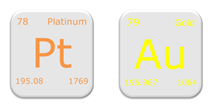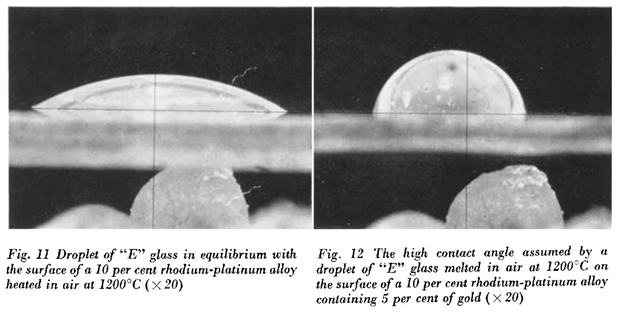
An alloying addition of gold to the platinum base leads to a significant increase in the contact angle of molten glass on the surface of the metal. In the range 1,100-1,400°C the contact angle of a typical borosilicate glass on pure platinum is, depending on the temperature, between about 14° and 40°.
This means that the surface of the platinum is very strongly wetted by the molten glass. An alloying addition of only 1% gold increases the contact angle significantly: with 3% gold the contact angle reaches 60° over a broad temperature range[i]. On the basis of this effect, the alloy PtAu95/5 has become the commercial standard material, as it combines good strength and forming characteristics with a low tendency to wetting by molten glass.
Over long periods of exposure at temperatures above approx. 1,000 °C, gold is depleted in the zone close to the surface as a result of the high vapour pressure of gold which is several orders of magnitude greater than that of platinum. This leads to a gradual increase in the tendency to wetting of the metal surface.

The Wetting of Platinum and Its Alloys by Glass
Source: Platinum Metals Rev., 9, 1965, pp. 130-135[ii]
[i] G. L. Selman, M.R. Spender, A.S. Darling, Research Laboratories Johnson Matthey & Co Ltd., “The Wetting of Platinum and Its Alloys by Glass”, Platinum Metals Review, Vol. 9, 1965, pp. 130-135
[ii] G. L. Selman, M.R. Spender, A.S. Darling, Research Laboratories Johnson Matthey & Co Ltd., “The Wetting of Platinum and Its Alloys by Glass”, Platinum Metals Review, Vol. 9, 1965, pp. 130-135